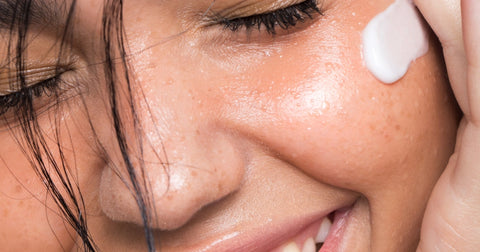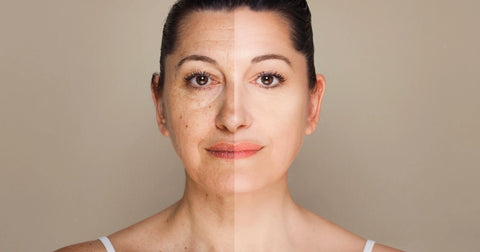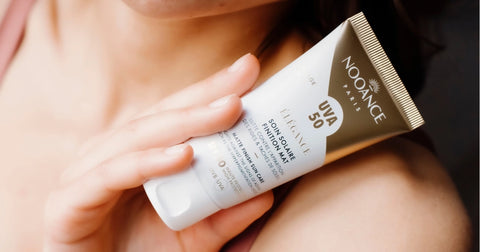In the ever-evolving world of skin care, polyglutamic acid stands out: this innovative ingredient offers intense hydration and an incomparable anti-aging effect . At NOOĀNCE, we are exploring how this star cosmetic active ingredient competes in effectiveness with the hyaluronic acid that we all know. Discover all the benefits of polyglutamic acid on the health and beauty of the skin.
What is Polyglutamic Acid?
Polyglutamic acid, or PGA (Polyglutamic Acid), is a natural polymer , obtained by bacterial fermentation of soybeans. It is increasingly popular in the cosmetic industry for its exceptional moisturizing properties . Just like hyaluronic acid, it attracts and retains moisture in the skin, but with certain characteristics that make it even more effective.

Polyglutamic Acid and Hyaluronic Acid: What are the Differences?
Although both of these ingredients are very hydrating, PGA has a mode of action and chemical properties that make it even better at fighting skin dehydration.
Water Retention Capacity
These two active ingredients attract moisture to the surface of the skin. But polyglutamic acid has the advantage of retaining up to four times more water than hyaluronic acid, providing superior and longer-lasting hydration.
Molecule Size
PGA molecules are larger and form a film on the surface of the skin, which helps maintain sufficient moisture levels to prevent moisture loss . With its higher molecular weight, it acts on the superficial layer of the skin, while hyaluronic acid penetrates deeper into the epidermis.
Anti-aging effects
Thanks to its water retention capabilities, polyglutamic acid forms a hydrating film that smoothes the surface of the skin and protects it from dryness , which is one of the aggravating factors of premature aging of the skin. Hyaluronic acid works from within to improve the appearance of fine lines.
Is it suitable for all skin types?
This acid is suitable for all skin types, but it is above all recommended for dry and dehydrated skin , as well as sensitive skin prone to redness or irritation. It is also an ingredient of choice in care formulations intended for mature skin thanks to its moisturizing power which helps prevent the signs of aging.
The Benefits of Polyglutamic Acid in Skin Care
Intense Hydration
This is the main advantage of polyglutamic acid. It provides long-lasting hydration and makes the skin softer, smoother and plumper.

Reduction of fine lines and wrinkles
It improves the skin's overall appearance and elasticity, which helps reduce the visible signs of aging .
Complexion lightening
Thanks to its lightening properties, PGA helps to regain a uniform and luminous complexion . It is a very interesting ingredient for skin problems such as brown spots, acne scars or hyperpigmentation.
Protection against external attacks
This acid has a protective function against the harmful effects of UV rays and pollution because it strengthens the skin barrier . By creating a protective film on the surface of the skin, it prevents dehydration and protects the epidermis from external aggressions.

How to Integrate Polyglutamic Acid into Your Skincare Routine?
Here are some best practices to make the most of the full potential of your polyglutamic acid cosmetic products in your beauty routine.
The Right Concentration
Even if it is a cosmetic active ingredient that is rather well tolerated by sensitive skin, it is important to choose care products with a dosage between 0.1 and 3% of polyglutamic acid. Overdose may cause redness or irritation. To increase its effectiveness, it is preferable to combine it with other ingredients adapted to your skin type.
Combine it with other Powerful Actives
Polyglutamic acid only acts on the upper layer of the skin. For deeply hydrated skin, the ideal is to use it in addition to hyaluronic acid . But other equally interesting ingredients also make it possible to act more quickly on the appearance of wrinkles, on hydration and on the elasticity of the skin: these are retinol , niacinamide and even centella . asiatica .
Application Tips
Polyglutamic acid is generally found in creams, masks, eye creams and/or moisturizing facial serums. It can be used morning and evening when there is a significant need for hydration: it is not an ingredient sensitive to the sun. Always apply your treatments to clean, dry skin , paying particular attention to the driest areas of the face.

Which Polyglutamic Acid Products Should You Choose? NOOĀNCE Recommendations
At NOOĀNCE, we integrate polyglutamic acid into our formulations to maximize hydrating and anti-aging benefits , offering an alternative or complement to hyaluronic acid.
Our Urban Sun Care is ideal as a day cream: it combines the benefits of a sunscreen, to protect the skin from UV rays responsible for oxidative aging, with the hydrating and plumping effect provided by polyglutamic acid.
###sunscreen-spf-30-moisturizing-non-greasy-very-high-protection###

The Multi-Active Serum highly concentrated in 5 forms of hyaluronic acid and anti-aging peptides helps fight against the appearance of signs of aging. The presence of polyglutamic acid in this treatment helps maintain hydration and reinforces the benefits of other active ingredients.
###multi-active-moisturizing-plumping-serum-5-hyaluronic-acids###

Polyglutamic acid therefore represents an exciting advancement in the field of skin care, offering unique benefits in terms of hydration and the fight against skin aging. At NOOĀNCE, we pride ourselves on bringing you the latest innovations in cosmetics, combining science and nature to reveal the best version of your skin.



